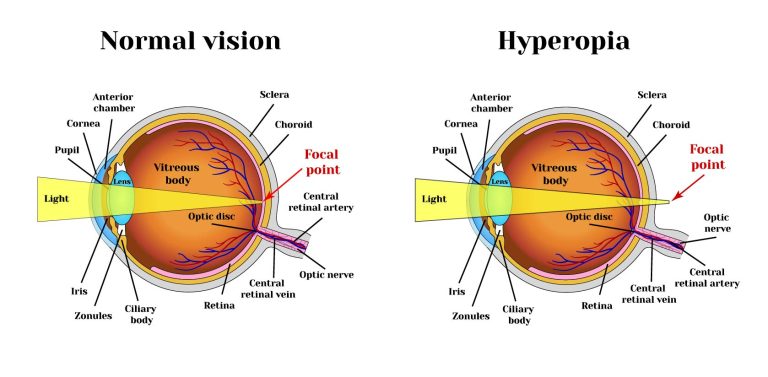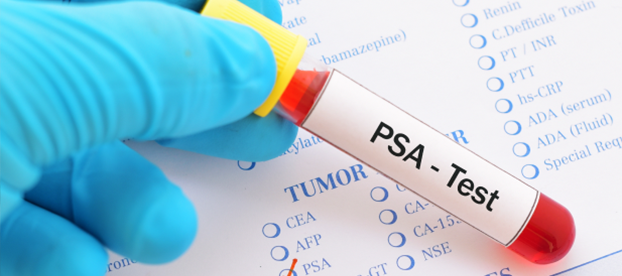Hyperopia
Learn more about Hyperopia - what it is, statistics in Singapore, its causes, symptoms, diagnostic tests, and treatments.
Table of Contents
ToggleWhat Is Hyperopia?
Hyperopia, commonly known as farsightedness, is a refractive error where distant objects can be seen more clearly than nearby objects. This condition occurs when the eyeball is too short or the cornea has too little curvature, causing light entering the eye to focus behind the retina rather than directly on it. As a result, close-up tasks like reading or working on a computer can become challenging.
Hyperopia is different from other refractive errors such as astigmatism and myopia (nearsightedness).

Hyperopia In Singapore: Statistics
In Singapore, hyperopia is less prevalent than myopia (nearsightedness) but still affects a significant portion of the population. According to a population-based study in Singaporean Chinese children aged 6 to 72 months, the prevalence of myopia and astigmatism are high but that of hyperopia is low.
Causes
Hyperopia is typically inherited, with genetic factors playing a significant role in its development. Other causes include:
- Abnormal Eye Shape – A shorter eyeball length or flatter cornea can result in hyperopia.
- Age-Related Changes – The lens of the eye becomes less flexible with age, which can contribute to farsightedness.
- Medical Conditions – Certain health issues like diabetes and small eye syndrome can also lead to hyperopia.
Symptoms
The symptoms of hyperopia may vary depending on the severity of the condition. Common symptoms include:
- Blurred vision, especially for nearby objects.
- Eye strain or discomfort.
- Headaches, particularly after reading or other close work.
- Squinting to see clearly.
- Fatigue after prolonged periods of near tasks.
Degrees Of Hyperopia
Hyperopia is typically measured in diopters (D), which represent the unit of refractive error. The degree of hyperopia is determined by the strength of the prescription needed to correct the vision. The measurement is positive, and the higher the positive number, the stronger the hyperopia.
Classification | Degree |
Mild | Up to +2.00 D |
Moderate | Between +2.25 D and +5.00 D |
High | Beyond +5.00 D |
Associated Complications
While hyperopia is often manageable, it can lead to complications if left untreated, including:
- Strabismus – Misalignment of the eyes, commonly known as crossed eyes.
- Amblyopia – Also known as lazy eye, where one eye develops better vision than the other.
- Accommodative Dysfunction – Difficulty in maintaining clear vision at different distances due to eye strain.
Diagnostic Tests
Hyperopia is diagnosed through a comprehensive eye examination that includes:
- Visual Acuity Test – Measures how well you can see at various distances.
- Refraction Test – Determines the prescription needed for corrective lenses.
- Retinoscopy – Involves shining a light into the eyes to observe the reflection from the retina.
- Autorefractors And Aberrometers – Advanced instruments that measure how light changes as it enters the eye, providing precise measurements of refractive errors.
Treatments
Several effective treatments are available for hyperopia:
- Eyeglasses – The most common and simplest method to correct farsightedness.
- Contact Lenses – Provide a wider field of vision and are suitable for those with active lifestyles.
- Refractive Surgery – Procedures like LASIK, PRK, and LASEK reshape the cornea to correct the refractive error.
- Lens Implants – Intraocular lenses (IOLs) can be implanted to correct hyperopia, particularly in cases where laser surgery is not suitable.
Contact Us For Diagnostic Tests And Treatment
Health365 has partnerships with trusted eye care specialists, clinics, and hospitals in Singapore. Contact us through the button below to inquire.
Related Articles
Dr Owen Hee – Ophthalmologist In Singapore
- November 4, 2024
Eye Screening In Singapore, Treatment, And Prevention
- August 5, 2024
Guide To Finding The Best Eye Specialist In Singapore
- August 5, 2024
Symptoms That May Indicate You Have An Eye Disease
- August 5, 2024














